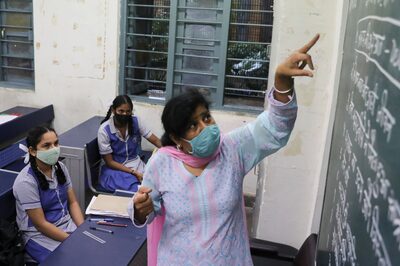
views
For seven art scholars of the Lalit Kala Akademi, art does not exist in exclusivity.They believe art and artists exist in the lives of the ordinary people - those in the towns and villages and that, artists do have a responsibility to make creative interventions into the society around.Validating their perceptions is the ongoing painting exhibition at the Lalit Kala Akademi here. Splashes of red, black, yellow and green greet you on entering the Akademi. An exhibition of paintings, installations and sculptures by seven research scholars of the Akademi, examine man’s relationship with nature in a precarious urban setup.A set of three paintings of Anjali Mohapatra, makes you pause. The oeuvre by this artist gives insights into life and nature. Thick textures and a matt effect of oil on canvas have been employed to create a striking painting ‘Nature’ - of an abandoned dilapidated house that has been covered with greens. Similarly, in ‘Leisure Time’, she draws rural women and men resting under a tree in a village set-up. The symbols of the countryside, like birds, ladders, earthenware, clothes tied into a bundle and the trees come alive in the painting. The colours are warm, rich yellows, ochre and burnt reds.Three abstract paintings in acrylic by Kishore Kumar Sahoo urge the viewers to stop and examine their inner lives and their relationship with nature.Graphic artist Lokanath Pradhan uses the technique of lithography to present an interesting creation ‘Hunger’s Man’. Likewise, artist Vandana Nayak’s creations are a maze of lines and forms. “These lines are like ripples in a pond for me. It’s an idea of a form that creates them,” she says.Then there are realistic sculptures in ceramic and stoneware. They are creations of P Bujinga Rao, Biswajita Moharana and Vijaya Chauhan. Some of the works have a special feel. They are untitled and can be interpreted in different ways.In an installation work, it appears like a box where a stack of wooden logs, numbered and tightly packed together are suspended over a plastic bulldozer that is placed on a world map.A partially cemented globe is also a part of the box which has a hand cementing tool on it.This is a sculptural realisation by Rao who is concerned about the rapid urbanisation and the resultant environmental degradation.“Numbered wooden logs assembled together are a common sight on roadsides these days. Huge trees are being felled to make way for larger roads.None realise the impact of this now but its repercussion will be felt later on,” he says.Vijaya, on the other hand, showcases a series of works on ceramic and stone on the theme of Braille language. “I wanted to show the difficulties which visually challenged people face while interacting and conveying with normal people,’ she says.Three of her works took her 45 days to complete. Human identity is the subject Biswajita works upon.The exhibition will conclude on Wednesday.




















Comments
0 comment